seats MERCEDES-BENZ GL-Class 2015 X166 Owner's Manual
[x] Cancel search | Manufacturer: MERCEDES-BENZ, Model Year: 2015, Model line: GL-Class, Model: MERCEDES-BENZ GL-Class 2015 X166Pages: 462, PDF Size: 9.09 MB
Page 5 of 462
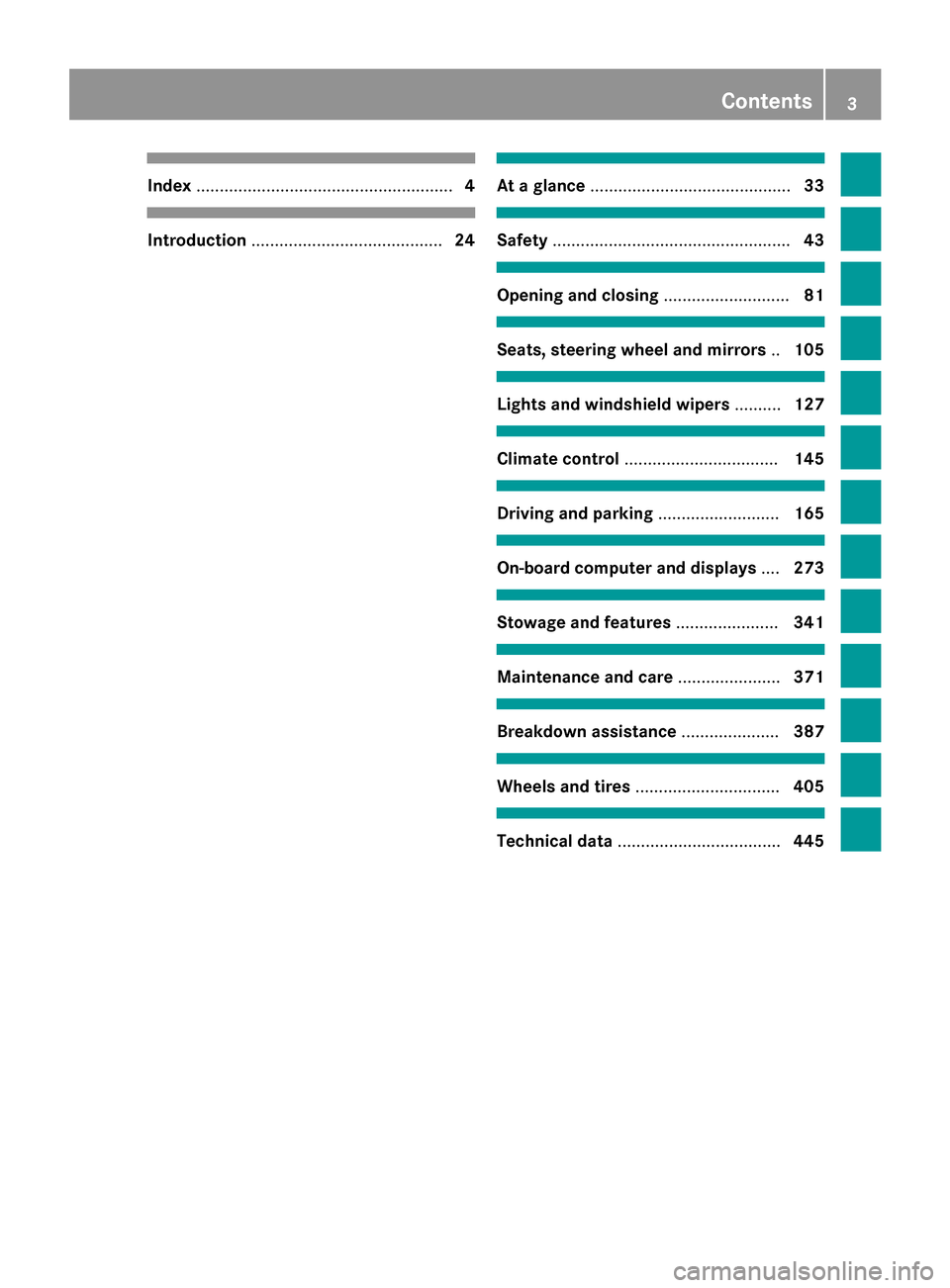
Index
....................................................... 4Introduction
......................................... 24 At a glance
........................................... 33 Safety
................................................... 43 Opening and closing
...........................81 Seats, steering wheel and mirrors
..105 Lights and windshield wipers
..........127 Climate control
................................. 145 Driving and parking
..........................165 On-board computer and displays
....273 Stowage and features
......................341 Maintenance and care
......................371 Breakdown assistance
.....................387 Wheels and tires
............................... 405 Technical data
................................... 445 Contents
3
Page 10 of 462

Combination switch
.......................... 131
Consumption statistics (on-board
computer) .......................................... 277
Convenience closing feature .............. 97
Convenience opening feature ............ 97
Coolant (engine) Checking the level ........................ .375
Display message ............................ 308
Filling capacity ............................... 453
Important safety notes .................. 452
Temperature (on-board com-
puter) ............................................. 289
Temperature gauge ........................ 274
Warning lamp ................................. 336
Cooling
see Climate control
Copyright ............................................. 31
Cornering light function Display message ............................ 305
Function/notes ............................ .133
Crash-responsive emergency light-
ing ....................................................... 137
Crosswind Assist ................................. 75
Crosswind driving assistance ............ 75
Cruise control Activating ....................................... 204
Activation conditions ..................... 204
Cruise control lever ....................... 204
Deactivating ................................... 205
Display message ............................ 319
Driving system ............................... 203
Function/notes ............................ .203
Important safety notes .................. 204
Storing and maintaining current
speed ............................................. 204
Cup holder
Center console .............................. 351
Important safety notes .................. 350
Rear compartment ......................... 352
Temperature controlled ................. 351
Third row of seats .......................... 352
Customer Assistance Center
(CAC) ..................................................... 29
Customer Relations Department ....... 29 D
Data see Technical data
Daytime running lamps
Display message ............................ 307
Function/notes ............................ .128
Switching on/off (on-board com-
puter) ............................................. 285
Declarations of conformity ................. 28
DEF Adding .......................................... .188
Display message ............................ 311
Filling capacity ............................... 451
Important safety notes .................. 450
Delayed switch-off
Exterior lighting (on-board com-
puter) ............................................. 286
Interior lighting .............................. 287
Diagnostics connection ......................28
Diesel .................................................. 449
Differential lock (display mes-
sage) .................................................. .314
Digital speedometer ......................... 278
DIRECT SELECT lever Automatic transmission ................. 176
Display messages
ASSYST PLUS ................................ 376
Calling up (on-board computer) ..... 292
Driving systems ............................ .312
Engine ............................................ 308
General notes ................................ 292
Hiding (on-board computer) ........... 292
KEYLESS-GO .................................. 326
Lights ............................................. 305
Safety systems .............................. 293
SmartKey ....................................... 325
Tires ............................................... 320
Vehicle .......................................... .323
Distance recorder
see Odometer
see Trip odometer
Distance warning (warning lamp) .... 338
Distance warning function Activating/deactivating ................. 283
Function/notes ................................ 70
Warning lamp ................................. 338 8
Index
Page 18 of 462

P
Paint code number ............................446
Paintwork (cleaning instructions) ... 379
Panic alarm .......................................... 44
Panorama roof with power tilt/
sliding panel
Important safety notes .................... 99
Opening/closing ............................ 101
Opening/closing the roller sun-
blind ............................................... 102
Problem (malfunction) ................... 103
Resetting ....................................... 102
Parking
Important safety notes .................. 190
Parking brake ................................ 192
Position of exterior mirror, front-
passenger side ............................... 124
Rear view camera .......................... 232
see PARKTRONIC
Parking aid
Active Parking Assist ..................... 228
see Exterior mirrors
see PARKTRONIC
Parking assistance
see PARKTRONIC
Parking brake
Display message ............................ 296
Electric parking brake .................... 192
Warning lamp ................................. 334
Parking lamps
Switching on/off ........................... 130
PARKTRONIC
Deactivating/activating ................. 227
Driving system ............................... 225
Function/notes ............................ .225
Important safety notes .................. 225
Problem (malfunction) ................... 228
Range of the sensors ..................... 225
Trailer towing ................................. 227
Warning displa y............................. 226
PASSENGER AIR BAG OFF
Indicator lamp .................................. 45
Problems (malfunction) .................. 303
Pets in the vehicle ............................... 67
Plastic trim (cleaning instruc-
tions) .................................................. 384 Power closing feature
......................... 90
Power washers .................................. 379
Power windows see Side windows
PRE-SAFE ®
(anticipatory occupant
protection) Display message ............................ 299
Operation ......................................... 60
PRE-SAFE ®
Brake
Activating/deactivating ................. 284
Display message ............................ 301
Function/note s................................ 76
Warning lamp ................................. 338
Program selector button .................. 180
Protection of the environment General notes .................................. 24
Pulling away
Trailer ............................................ 171
Pulling away (automatic transmis-
sion) .................................................... 170 Q
Qualified specialist workshop ........... 29 R
RACETIMER (on-board computer) .... 290
Radar sensor system Activating/deactivating ................. 287
Display message ............................ 315
Radiator cover ................................... 373
Radio Selecting a station ......................... 280
see separate operating instructions
Radio-controlled devices (instal-
ling) ..................................................... 369
Radio-wave reception/transmis-
sion in the vehicle
Declaration of conformity ................ 28
Reading lamp ..................................... 135
Rear compartment Exit/entry position (3rd row of
seats) ............................................. 112
Setting the air vents ...................... 163
Rear fog lamp
Switching on/of f........................... 130 16
Index
Page 19 of 462
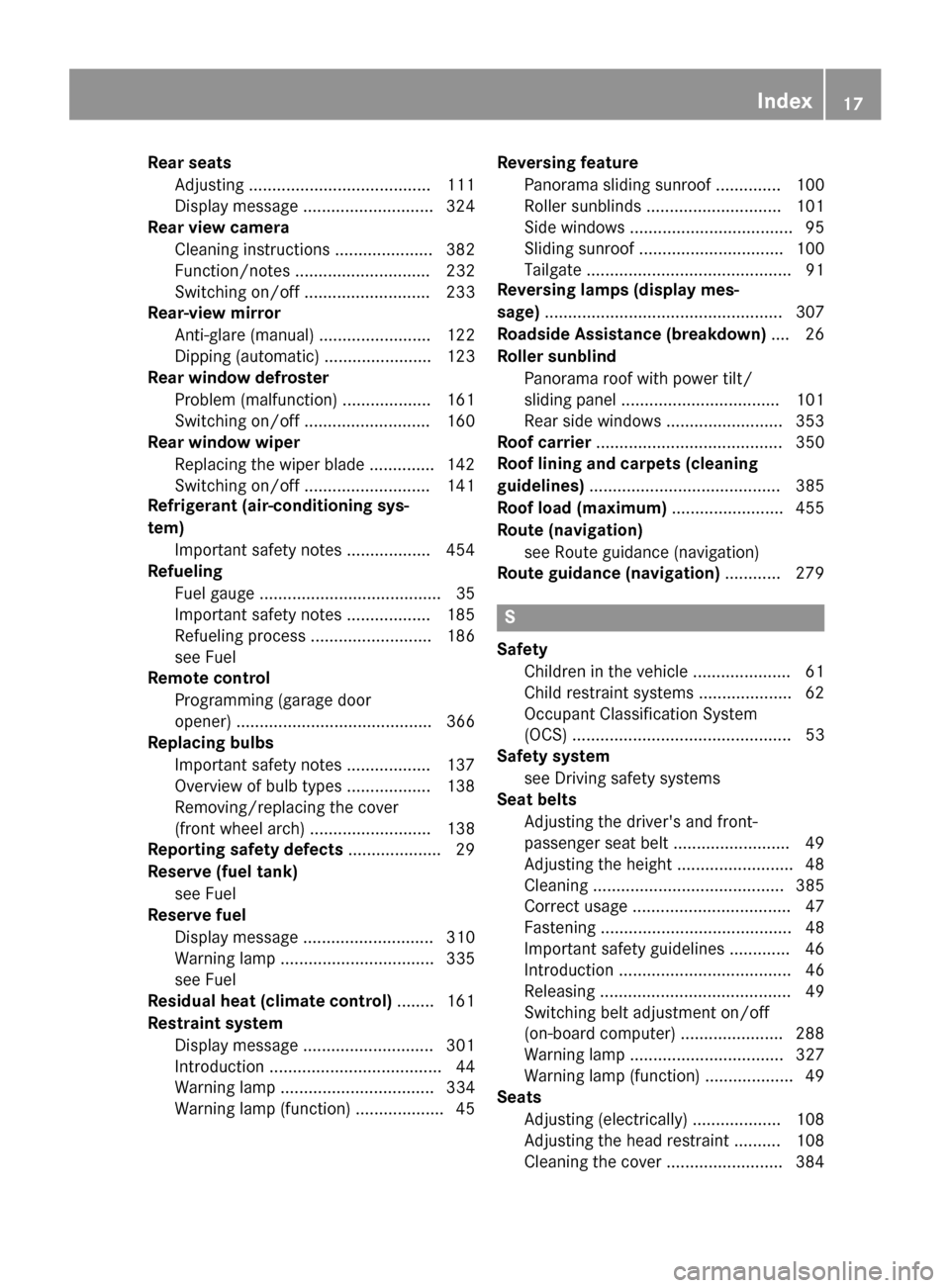
Rear seats
Adjusting ....................................... 111
Display messag e............................ 324
Rear view camera
Cleaning instructions ..................... 382
Function/note s............................. 232
Switching on/of f........................... 233
Rear-view mirror
Anti-glare (manual) ........................ 122
Dipping (automatic) ....................... 123
Rear window defroster
Problem (malfunction) ................... 161
Switching on/of f........................... 160
Rear window wiper
Replacing the wiper blad e.............. 142
Switching on/of f........................... 141
Refrigerant (air-conditioning sys-
tem)
Important safety notes .................. 454
Refueling
Fuel gaug e....................................... 35
Important safety notes .................. 185
Refueling process .......................... 186
see Fuel
Remote control
Programming (garage door
opener) .......................................... 366
Replacing bulbs
Important safety notes .................. 137
Overview of bulb types .................. 138
Removing/replacing the cover
(front wheel arch) .......................... 138
Reporting safety defects .................... 29
Reserve (fuel tank) see Fuel
Reserve fuel
Display message ............................ 310
Warning lamp ................................. 335
see Fuel
Residual heat (climate control) ........ 161
Restraint system Display message ............................ 301
Introduction ..................................... 44
Warning lamp ................................. 334
Warning lamp (function) ................... 45 Reversing feature
Panorama sliding sunroof .............. 100
Roller sunblind s............................. 101
Side windows ................................... 95
Sliding sunroof ............................... 100
Tailgate ............................................ 91
Reversing lamps (display mes-
sage) ................................................... 307
Roadside Assistance (breakdown) .... 26
Roller sunblind Panorama roof with power tilt/
sliding panel .................................. 101
Rear side window s......................... 353
Roof carrier ........................................ 350
Roof lining and carpets (cleaning
guidelines) ......................................... 385
Roof load (maximum) ........................ 455
Route (navigation) see Route guidance (navigation)
Route guidance (navigation) ............ 279 S
Safety Children in the vehicle ..................... 61
Child restraint systems .................... 62
Occupant Classification System
(OCS) ............................................... 53
Safety system
see Driving safety systems
Seat belts
Adjusting the driver's and front-
passenger seat belt ......................... 49
Adjusting the height ......................... 48
Cleaning ......................................... 385
Correct usage .................................. 47
Fastening ......................................... 48
Important safety guidelines ............. 46
Introduction ..................................... 46
Releasing ......................................... 49
Switching belt adjustment on/off
(on-board computer) ...................... 288
Warning lamp ................................. 327
Warning lamp (function) ................... 49
Seats
Adjusting (electrically) ................... 108
Adjusting the head restraint .......... 108
Cleaning the cover ......................... 384 Index
17
Page 20 of 462

Correct driver's seat position ........ 106
Entry position (3rd row of seats) .... 113
Exit position (3rd row of seats) ...... 114
Folding down/up (third row of
seats) ............................................ .111
Folding the 2nd row of seats
forward electrically ........................ 115
Folding the 2nd row of seats
forward manually ........................... 112
Folding the rear bench seat for-
wards/back ................................... 346
Important safety notes .................. 107
Overview ........................................ 107
Seat heating problem .................... 118
Seat ventilation problem ................ 119
Storing settings (memory func-
tion) ............................................... 124
Switching seat heating on/off ....... 116
Switching seat ventilation on/off .. 118
Selector lever
Cleaning ......................................... 384
Sensors (cleaning instructions) ....... 381
Service menu (on-board com-
puter) ................................................. .284
Service products Brake fluid ..................................... 452
Coolant (engine) ............................ 452
DEF special additives ..................... 450
Engine oil ....................................... 451
Fuel ................................................ 448
Important safety notes .................. 447
Refrigerant (air-conditioning sys-
tem) ............................................... 454
Washer fluid ................................... 453
Settings
Factory (on-board computer) ......... 289
On-board computer ....................... 285
Setting the air distribution ...............158
Setting the airflow ............................ 158
SETUP (on-board computer) ............. 289
Side impact air bag .............................52
Side marker lamp (display mes-
sage) ................................................... 307
Side windows Cleaning ......................................... 381
Convenience closing feature ............ 97
Convenience opening feature ..........97 Hinged side window
s....................... 96
Important safety information ........... 95
Opening/closing .............................. 96
Overview .......................................... 95
Problem (malfunction) ..................... 99
Resetting ......................................... 98
Sliding sunroof
Important safety notes .................... 99
Opening/closing ............................ 100
Problem (malfunction) ................... 103
Resetting ....................................... 100
see Panorama roof with power
tilt/sliding panel
SmartKey
Changing the battery ....................... 85
Changing the programming ............. 83
Checking the battery ....................... 85
Convenience closing feature ............ 98
Convenience opening feature .......... 97
Display message ............................ 325
Door central locking/unlocking ....... 82
Important safety notes .................... 82
Loss ................................................. 87
Mechanical key ................................ 84
Overview .......................................... 82
Positions (ignition lock) ................. 167
Problem (malfunction) ..................... 87
Starting the engine ........................ 170
Snow chains
Information .................................... 409
Snow drive program ....................... 256
Sockets
Center console .............................. 355
General notes ................................ 354
Luggage compartment ................... 355
Rear compartment ......................... 355
Specialist workshop ............................ 29
Special seat belt retractor .................. 61
Speed, controlling see Cruise control
Speedometer
Digital ............................................ 278
In the Instrument cluster ................. 35
Segments ...................................... 275
Selecting the unit of measure-
ment .............................................. 285
see Instrument cluster 18
Index
Page 26 of 462

Protection of the environment
General notes
H
Environmental note
Daimler's declared policy is one of compre-
hensive environmental protection.
The objectives are for the natural resources
that form the basis of our existence on this
planet to be used sparingly and in a manner
that takes the requirements of both nature
and humanity into account.
You too can help to protect the environment
by operating your vehicle in an environmen-
tally responsible manner.
Fuel consumption and the rate of engine,
transmission, brake and tire wear are affected by these factors:
R operating conditions of your vehicle
R your personal driving style
You can influence both factors. You should
bear the following in mind:
Operating conditions:
R avoid short trips as these increase fuel con-
sumption.
R always make sure that the tire pressures
are correct.
R do not carry any unnecessary weight.
R remove roof racks once you no longer need
them.
R a regularly serviced vehicle will contribute
to environmental protection. You should
therefore adhere to the service intervals.
R always have service work carried out at a
qualified specialist workshop.
Personal driving style:
R do not depress the accelerator pedal when
starting the engine.
R do not warm up the engine when the vehicle
is stationary.
R drive carefully and maintain a safe distance
from the vehicle in front.
R avoid frequent, sudden acceleration and
braking. R
change gear in good time and use each gear
only up to 00C3of its maximum engine speed.
R switch off the engine in stationary traffic.
R keep an eye on the vehicle's fuel consump-
tion. Environmental concerns and recom-
mendations
Wherever the operating instructions require
you to dispose of materials, first try to regen-
erate or re-use them. Observe the relevant
environmental rules and regulations when
disposing of materials. In this way you will
help to protect the environment. Genuine Mercedes-Benz parts
H
Environmental note
Daimler AG also supplies reconditioned major
assemblies and parts which are of the same
quality as new parts. They are covered by the same Limited Warranty entitlements as new
parts.
! Air bags and Emergency Tensioning Devi-
ces, as well as control units and sensors for these restraint systems, may be installed inthe following areas of your vehicle:
R doors
R door pillars
R door sills
R seats
R cockpit
R instrument cluster
R center console
Do not install accessories such as audio
systems in these areas. Do not carry out
repairs or welding. You could impair the
operating efficiency of the restraint sys-
tems.
Have aftermarket accessories installed at a qualified specialist workshop. 24
Introduction
Page 44 of 462
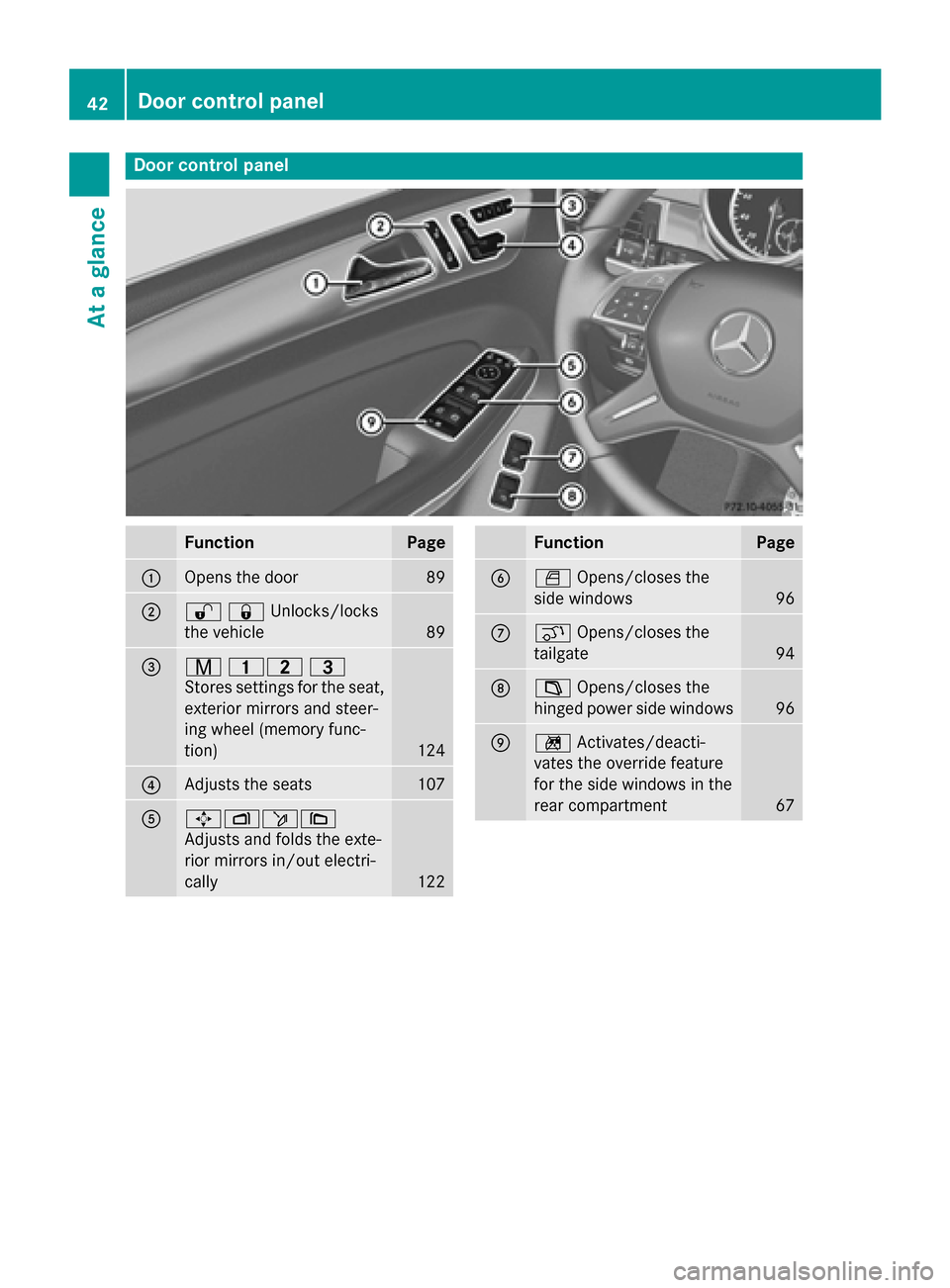
Door control panel
Function Page
0043
Opens the door 89
0044
00360037Unlocks/locks
the vehicle 89
0087
008D
00370038
Stores settings for the seat, exterior mirrors and steer-
ing wheel (memory func-
tion) 124
0085
Adjusts the seats 107
0083
0062007000F50071
Adjusts and folds the exte-
rior mirrors in/out electri-
cally
122 Function Page
0084
0062
Opens/closes the
side windows 96
006B
008C
Opens/closes the
tailgate 94
006C
00FD
Opens/closes the
hinged power side windows 96
006D
0089
Activates/deacti-
vates the override feature
for the side windows in the
rear compartment 6742
Door control panelAt a glance
Page 48 of 462

Depending on the person in the front-
passenger seat, the front-passenger front air
bag must either be disabled or enabled; see
the following points. You must make sure of
this both before and during a journey.
R Children in a child restraint system:
whether the front-passenger front air bag is
enabled or deactivated depends on the
installed child restraint system, and the age
and size of the child. Therefore, be sure to
observe the notes on the "Occupant clas-
sification system (OCS)" (Y page 53) and
on "Children in the vehicle" (Y page 61).
There you will also find instructions on
backwards- and forwards-facing child
restraint systems on the front-passenger
seat.
R All other persons: depending on the clas-
sification of the person in the front-
passenger seat, the front-passenger front
air bag is enabled or deactivated
(Y page 53). Be sure to observe the notes
on "Seat belts“ (Y page 46) and "Air bags"
(Y page 50). There you can also find infor-
mation on the correct seat position. Seat belts
Introduction A correctly fastened seat belt is the most
effective means of restraining the movement
of vehicle occupants in the event of an acci-
dent or overturn. This reduces the risk of
vehicle occupants coming into contact with
parts of the vehicle interior or being thrown
from the vehicle. Furthermore, the seat belt
helps to keep the vehicle occupants in the
best position in relation to the air bag.
The seat belt system consists of:
R Seat belts
R Emergency Tensioning Devices for the
front seat belts and the outer seat belts in
the second and third row of seats
R Belt force limiters for the front seat belts
and the outer seat belts in the second row of seats and the seat belts in the third row
of seats
If the seat belt is pulled quickly or suddenly
from the belt sash guide, the inertia reel
locks. The belt strap cannot be pulled out fur- ther.
Emergency Tensioning Devices tighten the
seat belts in an accident, pulling them close
against the occupant's body. They do not,
however, pull vehicle occupants back
towards the backrest.
Emergency Tensioning Devices do not cor-
rect an incorrect seat position or incorrectly
worn seat belts.
When activated, the belt force limiters reduce
the force exerted by the seat belt on the vehi-
cle occupants.
The belt force limiters for the front seats are
synchronized with the front air bags, which
absorb part of the deceleration force. This
makes it possible to reduce the forces to
which vehicle occupants are subjected during an accident.
! If the front-passenger seat is unoccupied,
do not insert the belt tongue into the buckle of the front-passenger seat. This may oth-
erwise lead to the triggering of the Emer-
gency Tensioning Device in the event of anaccident, which will then need to be
replaced.
Important safety notes The use of seat belts and child restraint sys-
tems is required by law in:
R all 50 states
R the U.S. territories
R the District of Columbia
R all Canadian provinces
Even where this is not required by law, all
vehicle occupants should correctly fasten
their seat belts before starting the journey. G
WARNING
If the seat belt is incorrectly fastened, it can-
not protect as intended. Furthermore, an 46
Occupant safetySafety
Page 52 of 462
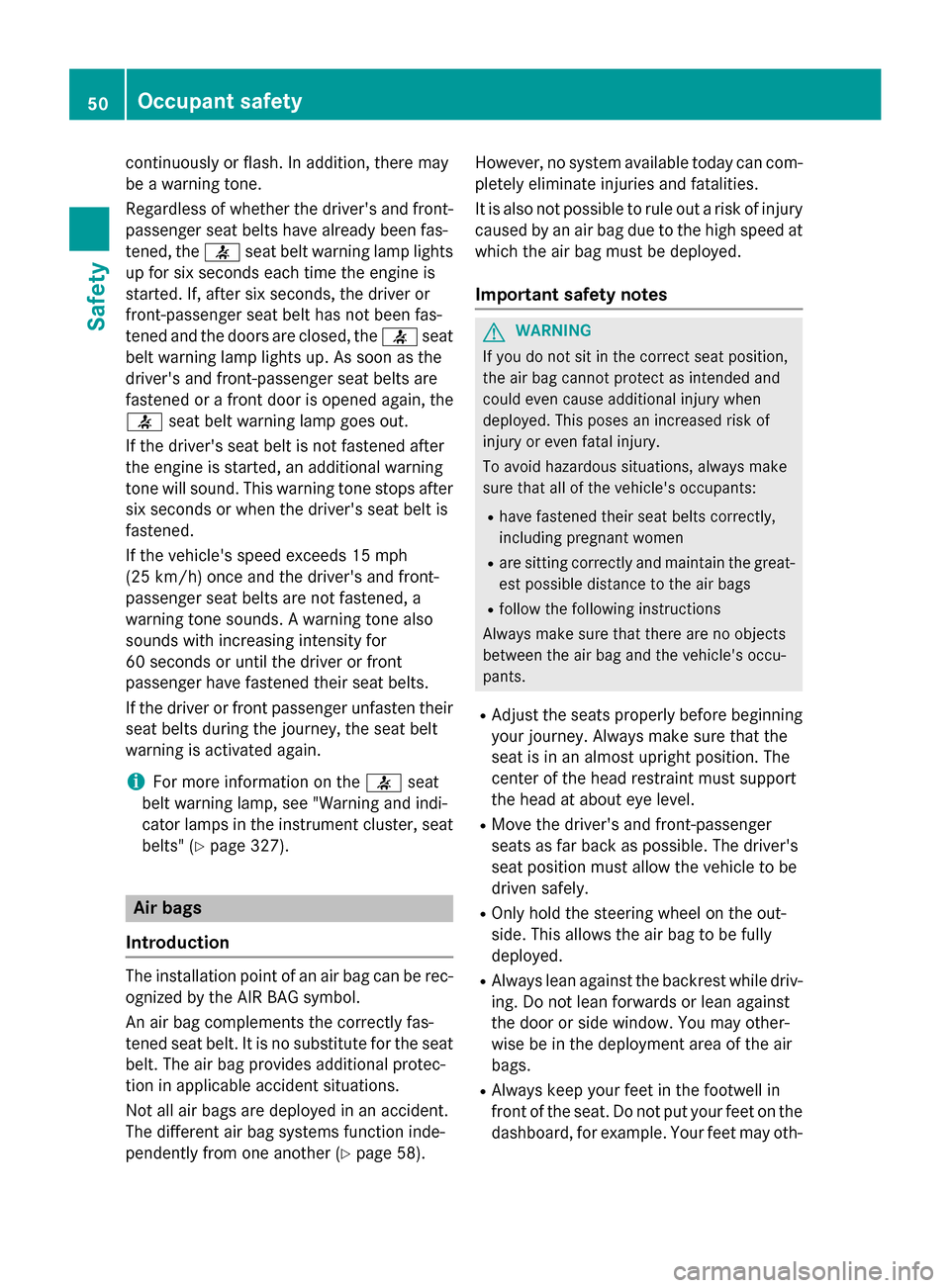
continuously or flash. In addition, there may
be a warning tone.
Regardless of whether the driver's and front- passenger seat belts have already been fas-
tened, the 0076seat belt warning lamp lights
up for six seconds each time the engine is
started. If, after six seconds, the driver or
front-passenger seat belt has not been fas-
tened and the doors are closed, the 0076seat
belt warning lamp lights up. As soon as the
driver's and front-passenger seat belts are
fastened or a front door is opened again, the
0076 seat belt warning lamp goes out.
If the driver's seat belt is not fastened after
the engine is started, an additional warning
tone will sound. This warning tone stops after six seconds or when the driver's seat belt is
fastened.
If the vehicle's speed exceeds 15 mph
(25 km/h) once and the driver's and front-
passenger seat belts are not fastened, a
warning tone sounds. A warning tone also
sounds with increasing intensity for
60 seconds or until the driver or front
passenger have fastened their seat belts.
If the driver or front passenger unfasten their
seat belts during the journey, the seat belt
warning is activated again.
i For more information on the
0076seat
belt warning lamp, see "Warning and indi-
cator lamps in the instrument cluster, seat
belts" (Y page 327). Air bags
Introduction The installation point of an air bag can be rec-
ognized by the AIR BAG symbol.
An air bag complements the correctly fas-
tened seat belt. It is no substitute for the seat
belt. The air bag provides additional protec-
tion in applicable accident situations.
Not all air bags are deployed in an accident.
The different air bag systems function inde-
pendently from one another (Y page 58).However, no system available today can com-
pletely eliminate injuries and fatalities.
It is also not possible to rule out a risk of injury
caused by an air bag due to the high speed at which the air bag must be deployed.
Important safety notes G
WARNING
If you do not sit in the correct seat position,
the air bag cannot protect as intended and
could even cause additional injury when
deployed. This poses an increased risk of
injury or even fatal injury.
To avoid hazardous situations, always make
sure that all of the vehicle's occupants:
R have fastened their seat belts correctly,
including pregnant women
R are sitting correctly and maintain the great-
est possible distance to the air bags
R follow the following instructions
Always make sure that there are no objects
between the air bag and the vehicle's occu-
pants.
R Adjust the seats properly before beginning
your journey. Always make sure that the
seat is in an almost upright position. The
center of the head restraint must support
the head at about eye level.
R Move the driver's and front-passenger
seats as far back as possible. The driver's
seat position must allow the vehicle to be
driven safely.
R Only hold the steering wheel on the out-
side. This allows the air bag to be fully
deployed.
R Always lean against the backrest while driv-
ing. Do not lean forwards or lean against
the door or side window. You may other-
wise be in the deployment area of the air
bags.
R Always keep your feet in the footwell in
front of the seat. Do not put your feet on the
dashboard, for example. Your feet may oth- 50
Occupant safetySafety
Page 53 of 462
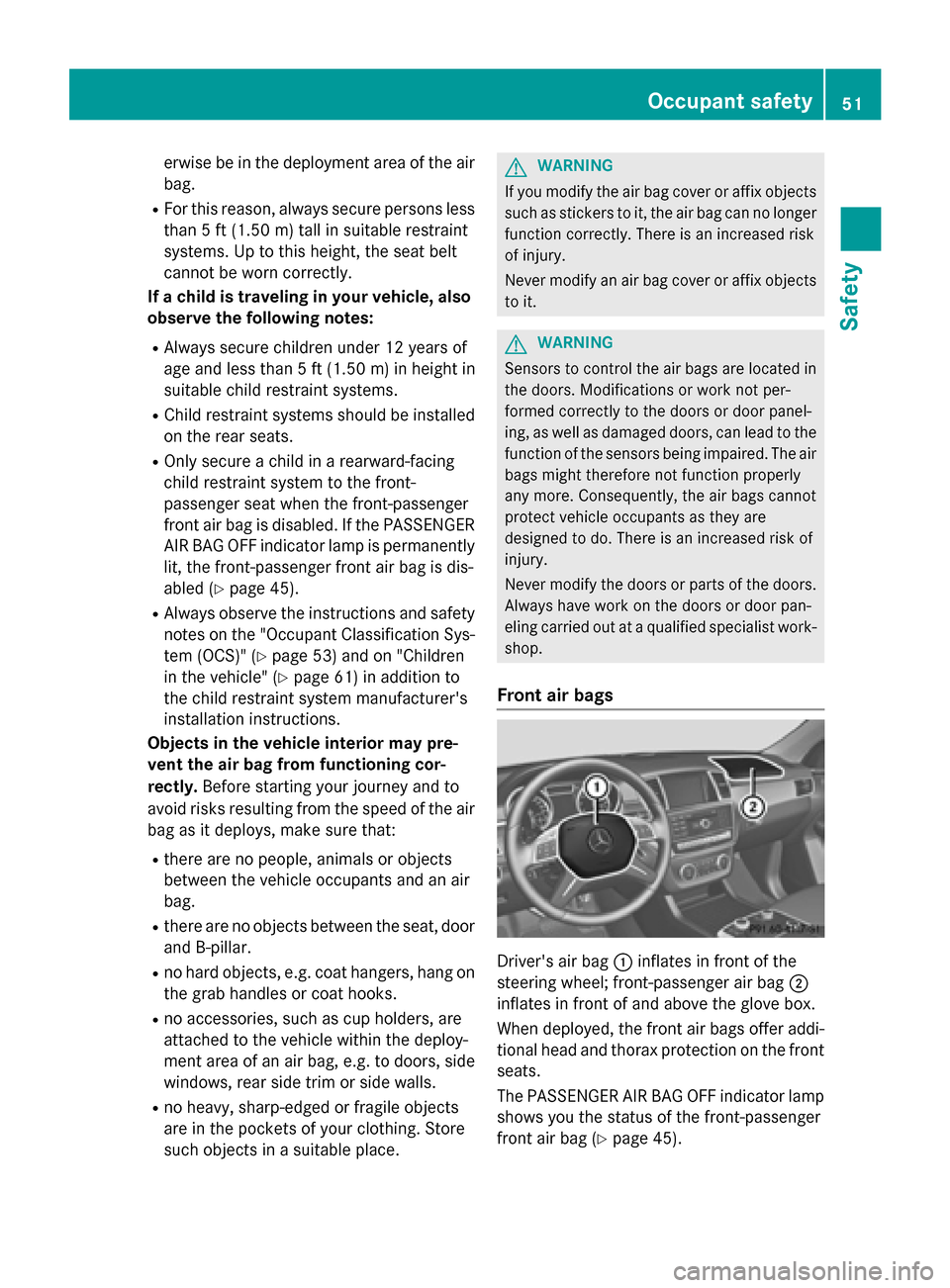
erwise be in the deployment area of the air
bag.
R For this reason, always secure persons less
than 5 ft (1.50 m) tall in suitable restraint
systems. Up to this height, the seat belt
cannot be worn correctly.
If a child is traveling in your vehicle, also
observe the following notes:
R Always secure children under 12 years of
age and less than 5 ft (1.50 m)in height in
suitable child restraint systems.
R Child restraint systems should be installed
on the rear seats.
R Only secure a child in a rearward-facing
child restraint system to the front-
passenger seat when the front-passenger
front air bag is disabled. If the PASSENGER
AIR BAG OFF indicator lamp is permanently
lit, the front-passenger front air bag is dis-
abled (Y page 45).
R Always observe the instructions and safety
notes on the "Occupant Classification Sys-
tem (OCS)" (Y page 53) and on "Children
in the vehicle" (Y page 61) in addition to
the child restraint system manufacturer's
installation instructions.
Objects in the vehicle interior may pre-
vent the air bag from functioning cor-
rectly. Before starting your journey and to
avoid risks resulting from the speed of the air bag as it deploys, make sure that:
R there are no people, animals or objects
between the vehicle occupants and an air
bag.
R there are no objects between the seat, door
and B-pillar.
R no hard objects, e.g. coat hangers, hang on
the grab handles or coat hooks.
R no accessories, such as cup holders, are
attached to the vehicle within the deploy-
ment area of an air bag, e.g. to doors, side
windows, rear side trim or side walls.
R no heavy, sharp-edged or fragile objects
are in the pockets of your clothing. Store
such objects in a suitable place. G
WARNING
If you modify the air bag cover or affix objects
such as stickers to it, the air bag can no longer function correctly. There is an increased risk
of injury.
Never modify an air bag cover or affix objectsto it. G
WARNING
Sensors to control the air bags are located in the doors. Modifications or work not per-
formed correctly to the doors or door panel-
ing, as well as damaged doors, can lead to the
function of the sensors being impaired. The air bags might therefore not function properly
any more. Consequently, the air bags cannot
protect vehicle occupants as they are
designed to do. There is an increased risk of
injury.
Never modify the doors or parts of the doors.
Always have work on the doors or door pan-
eling carried out at a qualified specialist work- shop.
Front air bags Driver's air bag
0043inflates in front of the
steering wheel; front-passenger air bag 0044
inflates in front of and above the glove box.
When deployed, the front air bags offer addi-
tional head and thorax protection on the front
seats.
The PASSENGER AIR BAG OFF indicator lamp
shows you the status of the front-passenger
front air bag (Y page 45). Occupant safety
51Safety Z